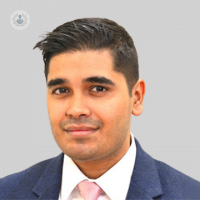Does my child have glue ear?
Written by:Glue ear is a very common condition among children that occurs when fluid builds up in the middle ear.
Here, Mr Kiran Varad, highly skilled consultant paediatric and general ENT surgeon, provides a detailed insight into glue ear in children, including causes, symptoms and treatment.

How do I know if my child has glue ear?
There are several signs and symptoms that may indicate a child has glue ear, including:
- Hearing difficulties: Children with glue ear may have trouble hearing sounds, especially in noisy environments. They may also increase the TV volume to high levels at home.
- Speech problems: Children with glue ear may struggle to understand speech, or may speak more loudly than usual. They may also have problems with the pronunciation of words.
- Behavioural problems: Children with glue ear may become irritable, inattentive, or display behavioural problems, caused by the frustration with their hearing difficulties.
- Learning difficulties: Slow progress at nursery or school
- Balance problems: Glue in the middle ear can affect balance and coordination, leading to clumsiness or unsteadiness.
- Tugging at the ears: If children also have ear infections, they may repeatedly tug at their ears, indicating discomfort or pain.
What causes glue ear in children?
Glue ear in children is caused by fluid building up in the middle ear behind the eardrum. This fluid can cause hearing problems. Although the exact cause of glue ear is not fully understood, several factors can contribute to its development, including:
- Eustachian tube dysfunction: The eustachian tubes help to drain fluid from the middle ear and to regulate air pressure. If they do not function properly, this can cause fluid to accumulate in the middle ear.
- Allergies and recurrent respiratory infections: These can cause inflammation and swelling of the eustachian tubes, leading to fluid accumulation in the middle ear. This can be further affected by large adenoids blocking the eustachian tubes.
- Genetics: Some children may be genetically predisposed to glue ear due to a family history of the condition.
- Environmental factors: Exposure to second-hand cigarette smoke and air pollution can increase the risk for glue ear in children.
How does glue ear affect quality of life?
Glue ear can have a significant impact on a child's quality of life, including:
- Hearing difficulties: Children with glue ear may have temporary hearing loss, making it difficult for them to hear sounds and understand speech. This can affect their speech development and communication skills.
- Learning difficulties: Hearing loss can also make it harder for children to concentrate and learn at school, leading to decreased academic performance.
- Behavioural problems: Children with glue ear may become frustrated or withdrawn if they struggle to hear and to communicate effectively. This can lead to behavioural problems.
Treatment can help alleviate these symptoms and improve quality of life. It is important for parents to address glue ear promptly to prevent negative impacts on a child's development and wellbeing.
How is glue ear treated?
Treatment for glue ear in children depends on how severe the condition is, and can include:
- Observation: In many cases, glue ear will resolve on its own without treatment. In these cases, an ENT specialist may recommend observation and monitoring for improvement over time (usually over a period of three months).
- Otoventâ Balloon: This is a balloon that children inflate with their nose. The balloon opens up the eustachian tubes, which may help clear the glue over time.
- School changes: It is important to make a child’s nursery or school aware of the glue ear. Teachers can implement strategies to account for the hearing loss, including sitting a child nearer the front of the class so that they can hear better.
- Surgery: If other treatments are not effective, an ENT specialist may recommend the insertion of ventilation tubes (grommets), which are small tubes that are placed through the eardrum to allow fluid to drain from the middle ear. If a child has symptoms of large adenoids (such as, frequent colds or a persistently blocked nose), these can be removed at the same time.
- Hearing aids: An alternative to surgery for persistent glue ear involves using hearing aids to improve a child’s hearing. These can be a hearing aid on a headband or traditional hearing aids that go in the ears. Not all children will be compliant with hearing aids, however.
Parents should always consult an ENT specialist to determine the best course of treatment for their child’s individual needs and symptoms.
Do children grow out of glue ear?
Most children will only have glue ear temporarily, making a full recovery with no long-term consequences.
In some children, however, glue ear and persistent hearing loss will continue, leading to the issues described above and needing further intervention.
Mr Kiran Varad is a highly respected consultant paediatric and general ENT surgeon with over a decade of experience.
If you require expert diagnosis and treatment for your child’s glue ear, do not hesitate to book an appointment with Mr Varad via his Top Doctors profile today.


